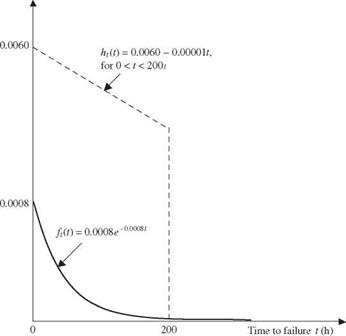Importance sampling technique
The importance sampling technique concentrates the distribution of sampling points in the part of the domain that is most “important” for the task rather than spreading them out evenly (Marshall, 1956). Refer to the problem of evaluating an integral in Eq. (6.49) by the sample-mean method. The importance sampling technique attempts to generate M sampling points to reduce the variance of G given by Eq. (6.61).
Rubinstein (1981) showed that the PDF fx(x) that minimizes Eq. (6.61) can be obtained as
|
|||
|
|
||
|
|||
|
|||
|
|||
|
|||
 |
|||
 |
|||
|
|||
|
From condition (i), the coefficient b can be obtained easily as b = 0.00001. Substituting b = 0.00001 into ht(t), one can verify that condition (ii) is also satisfied. Therefore, ht(t) = 0.006 — 0.00001 x t is a legitimate PDF in 0 < t < 200. To generate random variates from ht(t), the CDF-inverse method can be used because the CDF of ht(t) can be obtained easily as
Ht(T) = U = (0.006 — 0.00001t) dt = 0.006T — ^°-002001) T 2
Solving for T in terms of U, one obtains
in which a = 0.006 and b = 0.00001. Based on the boundary conditions of a CDF, that is, Ht(t = 0) = 0 and Ht(t = 200) = 1, the only valid expression for T from ht(t) is
T 2a — V 4a2 — 8bU
= 2b
Hence the preceding equation can be used to generate random variates from ht(t). The algorithm for this example can be outlined as follows:
1. Generate n standard uniform random variates ui from U(0, 1).
2. Compute ti according to Eq. (6.73), yielding n random variates from ht(t) = 0.006 —
0. 00001t, 0 < t < 200.
3. Estimate the pump failure probability as
|
|
|
|
|
|
|
|

![]()
4. To assess the error associated with the estimated pump failure probability by the preceding equation, compute the following quantity:
 |
|
|
|
|
|
|
|

Using this algorithm, the estimated pump failure probability is pf = 0.14767, whereas the exact failure probability is 0.147856. The associated standard error can be computed as
sp f = 0.00023
Assuming normality for the estimated pump failure probability, the 95 percent confidence interval containing the exact risk pf is
pf ± 1.96spf = (0.14722,0.14813)
Comparing the solutions with those of Examples 6.6 and 6.7, it is observed that with the same n = 2000, the importance sampling method has a 0.126 percent error. The magnitude of error and the accuracy level are somewhat worse than the sample- mean procedure but are still far better than the hit-and-miss algorithm. The accuracy of the importance sampling technique depends on how ht(t) is specified. As can be observed from Problem 6.29, use of the exponential function for ft(t) improves the accuracy tremendously.







Leave a reply